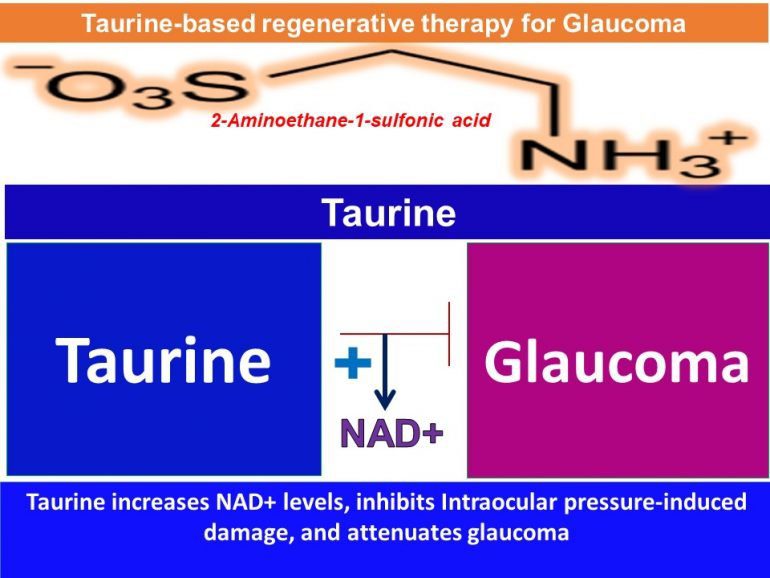20% off for referrals. Buy packages of 4 drips, 5th is free!
Taurine Could Prevent Glaucoma
Taurine Glaucoma
Taurine-based regenerative therapy for greatly improving Glaucoma: Taurine/2-Aminoethane-1-sulfonic acid increases the expression of genes that promote regeneration, promotes reprogramming of aged eye cells, increases telomerase expression, increases Nicotinamide mononucleotide adenylyltransferase 1, which increases NAD+ levels, improves neuronal dysfunction, and protects against and reverses glaucoma, via up regulation of its target gene.
From the significance of the study to public health relevance:
Given that:
- Glaucoma is a neurodegenerative disease
- More than 80 million people worldwide are affected by Glaucoma
- Glaucoma is the second leading cause of blindness
- Glaucoma has no cure
- vision lost due to glaucoma is irreversible
- The global economic cost spent for Glaucoma treatment is enormous


- A way to induce regeneration of ganglion cells that were lost in Glaucoma
- A cheaper alternative to the existing expensive anti-glaucoma drugs
- A side-effect-free natural product-based drug
- A way to cure, not just treat, Glaucoma permanently.
What is known?
Prof.Simon’s research team has recently shown that
- Glaucoma-prone mice suffer from mitochondrial abnormalities, resulting in neuronal dysfunction.
- NAD+ levels decrease with age.
- Administration of Niacin/Vitamin-B3 protects against glaucoma, suggesting that increasing the expression of Nmnat1, a key NAD+-producing enzyme, protects against glaucoma, suggesting that increasing the expression of Nmnat1 in glaucoma patients may alleviate glaucoma.
From research findings to Therapeutic opportunity:
This study suggests, for the first time, that Taurine, by increasing the expression of its target genes, it could increase the expression of Nmnat1. Thereby, it could: increase NAD+ levels; increase telomerase expression; increase the expression of genes that promote regeneration; promote reprogramming of aged eye cells; decrease Intraocular pressure; improve pressure-induced damage; increase insulin sensitivity; and alleviate/reverse/cure glaucoma. Thus, Taurine, either alone or in combination with other drugs or compounds or regenerative agents, can be used to cure or reverse or treat Glaucoma.
Does taurine help glaucoma?
Increasing data indicate that taurine supplement may be effective in slowing down the progression of retinal diseases (including glaucoma, AMD, and DR), thus suggesting that taurine can be a promising candidate for the prevention or as adjuvant treatment of these diseases.
What foods are high in taurine?
The best natural sources of taurine include:
- Scallops. Shellfish have some of the highest taurine content, especially scallops
- Tuna. Whether you get it fresh or from a can, tuna is an excellent source of taurine
- Tilapia. Freshwater fish are high in taurine as well
- Octopus
- Turkey
- Chicken
- Seaweed
- Beef
What are the symptoms of taurine deficiency?
Taurine deficiency can interfere with different metabolic processes in your body, which may result in:
- Vision impairment.
- High blood pressure.
- Hypothyroidism (overactive thyroid)
- Kidney disorder.
- Anxiety.
- Obesity.
- Depression.
Is taurine worth taking?
Taurine is vital for a person’s overall health. It is one of the most abundant amino acids in the muscle tissue, brain, and many other organs in the body. Taurine plays a role in several essential body functions, such as: regulating calcium levels in certain cells.
Can you have too much taurine?
According to the best available evidence, taurine has no negative side effects when supplemented appropriately. One 2019 report suggests that the highest daily dose of taurine you can safely consume is 3 grams per day.
How long does it take taurine to start working?
Some patients with severe heart failure rapidly improve from NYHA class IV to II after 4-8 weeks of treatment. Improvement seems to continue for as long as taurine treatment is continued, up to one year.

